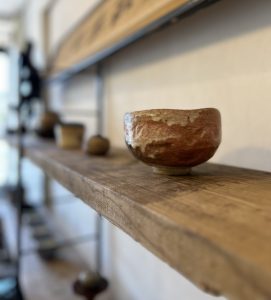お抹茶と器との相性とは(愛知県名古屋市千種区姫池通 骨董買取 古美術風光舎)
2024.02.10
皆さまこんにちは。スタッフHでございます。
最近、毎日大量に水を飲んでいるという友人の話を聞いて、私は全く足りていないなと実感しました。あまり水分をとらなくても平気な方で、放っておくと何時間も飲まなかったりします。ただ寒い時は喉に温かい飲み物を通すと精神的にリラックスするので(個人的見解です)、夏よりも水筒のお茶の減りが早いです。日替わりで色々な温かいお茶を楽しんでいます。
さて、日本の伝統的なお茶といえばお抹茶ですが、今や世界中で愛される味となりました。抹茶は「Maccha」ではなく、「Matcha」と表記されるそうで、その方が「ちゃ」の発音に間違いがないからだそうです。
店内には抹茶の色が映えそうな赤楽茶碗がございます。名古屋市八事窯の中村道年氏の作品です。

名古屋は抹茶を楽しむ習慣が浸透した土地柄であることから瀬戸や常滑をはじめ、名古屋城内の御庭焼きなど様々な茶道具が制作されました。
中でも楽焼は名古屋独自の個性がみられ、江戸時代後期の萩山焼や宗玄焼、豊楽焼などの流れが名古屋市にある八事窯の中村道年へと引き継がれて今日に至っているとのことです。
初代中村道年は京都に生まれ、幼少より陶器作りを志し1923年に名古屋・八事に築窯しました。染付、赤絵、御本、刷毛目、伊賀、楽焼と幅広く制作し、戦後は楽焼を専門とし現在は5代目が引き継いでいらっしゃいます。
恥ずかしながら、楽焼=京都の抹茶茶碗、くらいの知識しかありませんでしたが、調べてみるとまさに茶の湯専用の茶碗として生まれたことを再認識しました。
茶道は鎌倉時代に禅宗と共に中国から入っていましたが、当時は中国の唐物と呼ばれる天目や青磁の茶碗が使われていました。次第に朝鮮半島で焼かれた高麗茶碗も使われるようになりますが、茶の湯専用の茶碗ではありませんでした。
そこで千利休が瓦職人であった長次郎に自分の求める茶道を表現する茶碗として作らせたのが楽茶碗の始まりと言われています。
唐物や高麗茶碗は熱伝導率が高く手で持つには熱すぎるため帛紗(ふくさ)をあてて飲みますが、楽茶碗はそのまま持って飲める茶碗でもありました。そういえば素手で持って飲めることを当たり前だと思っておりました。
また1000度以下の温度で短時間焼成し水につけて急冷するため、焼締まりが少なく、吸水性のある茶碗となっています。滑らかな「濃茶」を点てるにはこの吸水性が必要だそうです。千利休の時代には「茶」といえば「濃茶」を指し、薄茶の時のみ「薄茶」と記述されているそうです。楽茶碗は侘茶の精神を表すだけでなく、機能的でもあったのですね。
制作方法はろくろを使わず、土をこねて円盤状の粘土を手のひらで少しずつ立ち上げて茶碗の形にする「手びねり」「手捏ね(てづくね)」と呼ばれる技法で作られます。手のひらで包んで飲む茶碗ですから手の痕が残る温かみのあるこの技法は理にかなっているように思えます。その後へらで内部はお茶が綺麗に立つよう、口は口当たりがいいように削られます。まさに茶の湯のための茶碗です。
楽焼のルーツと言われる中国河南地方、明時代の三彩釉と焼成や釉技術などは基本的に同じですが、楽焼ではそのカラフルな色釉技法を使って黒と赤のみを表現しました。当初は「今焼」と呼ばれ、漆黒の茶碗と濃い緑の抹茶とのコントラストは当時の人々には新鮮に映ったことでしょう。豊臣秀吉は赤楽茶碗の方を好んだとか。楽焼の由来は秀吉が建てた邸宅「聚楽第」の近くでとれた土を使ったため「聚楽焼茶碗」と呼ばれ、その後「楽茶碗」となったようです。
常に新しい価値観や物を生み出した千利休のパワーには恐れ入ります。タイムスリップできるならぜひお会いしてみたいものです。
それでは、またの機会に。

Hello everyone. This is Staff H.
Recently, I heard a friend of mine say that she drinks a lot of water every day, which made me realize that I am not drinking enough at all. I am a person who is fine without drinking much water, and if left alone, I may not drink for hours. However, when it is cold, having a warm drink down my throat relaxes me mentally (in my opinion), so I run out of tea in my water bottle faster than in the summer. I enjoy a variety of hot teas on different days.
Now, the traditional Japanese tea is matcha (powdered green tea), and it has become a favorite taste all over the world. Matcha is written as “Matcha” instead of “Maccha”. It is said that this is because it is easier to pronounce “cha” correctly.
In the store, there is an akaraku tea bowl that looks like it would be a perfect matcha color. It is the work of Nakamura Dounen of Yagotogama in Nagoya City.
Since the custom of enjoying powdered green tea was widespread in Nagoya, various tea utensils were produced in Seto, Tokoname, and Oniwa-yaki in Nagoya Castle.
Raku ware, in particular, has a unique character unique to Nagoya, and the flow of Hagiyama ware, Sogen ware, and Houraku ware from the late Edo period has been passed down to Nakamura Michitoshi of the Yagoto Kiln in Nagoya City to this day.
Nakamura Dounen was born in Kyoto, aspired to make pottery from an early age, and established his own kiln in Yagoto, Nagoya in 1923. He produced a wide range of pottery including Sometsuke, Akae, Gohon, Hakeme, Iga, and Raku ware. After the war, he specialized in Raku ware, which is now taken over by the fifth generation.
I am ashamed to say that my knowledge of Raku ware was limited to the concept that Raku ware was a tea bowl for powdered green tea in Kyoto, but when I looked into it, I realized again that it was born as a tea bowl for the tea ceremony.
The tea ceremony was introduced from China along with Zen Buddhism in the Kamakura period (1185-1333), and at that time, tea bowls made of tenmoku or celadon porcelain, called Chinese karamono, were used. Gradually, Koryo tea bowls fired in the Korean peninsula also came into use, but they were not tea bowls exclusively for the tea ceremony.
It is said that Sen no Rikyu had Chojiro, a tile craftsman, make Raku tea bowls as tea bowls that expressed the tea ceremony that he wanted.
Karamono and Korai tea bowls are too hot to be held in the hand because of their high thermal conductivity, so they are held with a fukusa, but the Raku tea bowl was a tea bowl that could be held and drank as it was. Come to think of it, I had taken it for granted that I could hold it with my bare hands and drink from it.
In addition, because it is fired for a short time at a temperature of less than 1000 degrees Celsius and cooled rapidly by dipping it in water, it is a tea bowl with little firings and water absorbency. This water absorbency is said to be necessary for making smooth “thick tea”. In Sen no Rikyu’s time, the word “tea” referred to “koicha” (thick tea), and “usucha” was used only for thin tea. Raku tea bowls not only expressed the spirit of wabicha, but were also functional.
The production method does not use a potter’s wheel, but uses a technique called “tebineri” or “tezukune,” in which the clay is kneaded into a disk shape and raised gradually with the palm of the hand to form a tea bowl. This technique seems to make sense because the tea bowl is wrapped in the palm of the hand, leaving the warmth of the hand imprints. After that, a spatula is used to shave the inside of the bowl so that the tea will stand beautifully and the mouth will be smooth to the touch. This is truly a tea bowl for the tea ceremony.
Raku ware is said to have its roots in the Henan region of China, where the firing and glazing techniques are basically the same as those of the three-color glazes of the Ming dynasty, but Raku ware used its colorful colored glaze techniques to express only black and red. Initially called “Imayaki,” the contrast between the jet-black tea bowl and the dark green matcha must have appeared fresh to the people of the time. Toyotomi Hideyoshi preferred the red Raku tea bowl. The origin of Raku ware is said to be “Juraku ware tea bowl” because it was made from soil obtained near “Juraku-dai”, a mansion built by Hideyoshi, and later became “Raku tea bowl”.
I am amazed at the power of Sen no Rikyu, who always created new values and things. If I could go back in time, I would love to meet him.
See you next time.
******************
ご実家の整理やお片付けなどをされている方のご相談などが多くございます。
お片付けなどくれぐれもご無理のないようになさってくださいませ。
風光舎では古美術品や骨董品の他にも絵画や宝石、趣味のお品など様々なジャンルのものを買受しております。
お片付けをされていて、こういうものでもいいのかしらと迷われているものでも、どうぞお気軽にご相談下さいませ。
また風光舎は、出張買取も強化しております。ご近所はもちろん、愛知県内、岐阜県、三重県その他の県へも出張いたします。
まずは、お電話お待ちしております。
愛知県名古屋市千種区姫池通
骨董 買取【古美術 風光舎 名古屋店】
TEL052(734)8444
10:00-18:00 OPEN
#骨董買取#古美術買取#出張買取#無料査定#生前整理#遺品整理#家じまい#実感じまい#掛け軸#絵画#木箱入り茶碗#刀剣#洋食器#貴金属

